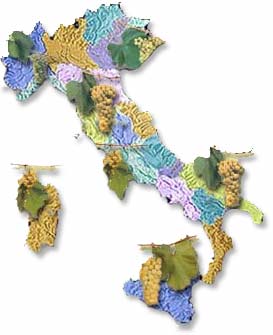HISTORY AND BACKGROUND OF ITALIAN WINES

PRESENT
TIME
Italy is home to some of the oldest wine producing regions in the world and is
world's second largest wine producer behind France. Italian wine is exported
around the world and is part of the italian culinary tradition and food habit.
Rarely you will not find a bottle of red or white wine on any table in any home
or restaurant. Italians lead the world in wine consumption by volume with 70
liters per year per head. Grapes are grown in almost every region of the country
and there are more than one milion vineyards under cultivation.
PAST TIME
Etruscans and Greek settlers produced wine in Italy before the Romans started
their own vineyards in the 2nd century BC. Roman Grape-growing and winemaking
was prolific and well-organized, pioneering large scale production and storage
techniques like barrel-making and bottling.

HISTORY
OF ITALIAN WINE
Allthough vines had been cultivated from the wild VITIS VINIFERA grape for
millennia, it wasn't until the Greek colonization i Italy that wine-making
flourished. Viticulture was introduced by the Mycenaen Greeks first into Sicily
and followed by the other southern Italian regions: Calabria, and Puglia. Thanks
to extensive Greek colonositaion around 800 BC vituculture was well established
in those regions. It was during the Roman defeat of the Carthaginians
(acknowledged masters of wine-making) in the 2nd century BC, that Italian wine
production begun to further flourish. LArge scale slave-run plantations sprang
up in many coastal areas and spread to such an extend that in AD 92 Roman
Emperor DOMITIAN was forced to destroy a great number of vineyards to free up
fertile land for food production.
During this time viticulture outside of Italy was prohibited under Roman Law.
Exports to the provinces were reciprocated in exchange of more slaves especially
from Gaul (todays France), where trade was intense. It became customary to mix
wine with a good portion of water, which may otherwise have been unpalatable,
making wine drinking a fundamental part of early Italian life.
As the laws on provincial viticulture were relaxed, vast vineyards began to
flourish in the rest of Europe especially in the Provinces of Gaul and Hispania
known at the present days as France and Spain. This coincided with the
cultivation of new vines, like biturica (ancestor of the cabernets). These
vineyards became hugely successful, to the point that Italy ultimately became an
import centre for provincial wines.
 PRESENT
TIME
PRESENT
TIME HISTORY
OF ITALIAN WINE
HISTORY
OF ITALIAN WINE